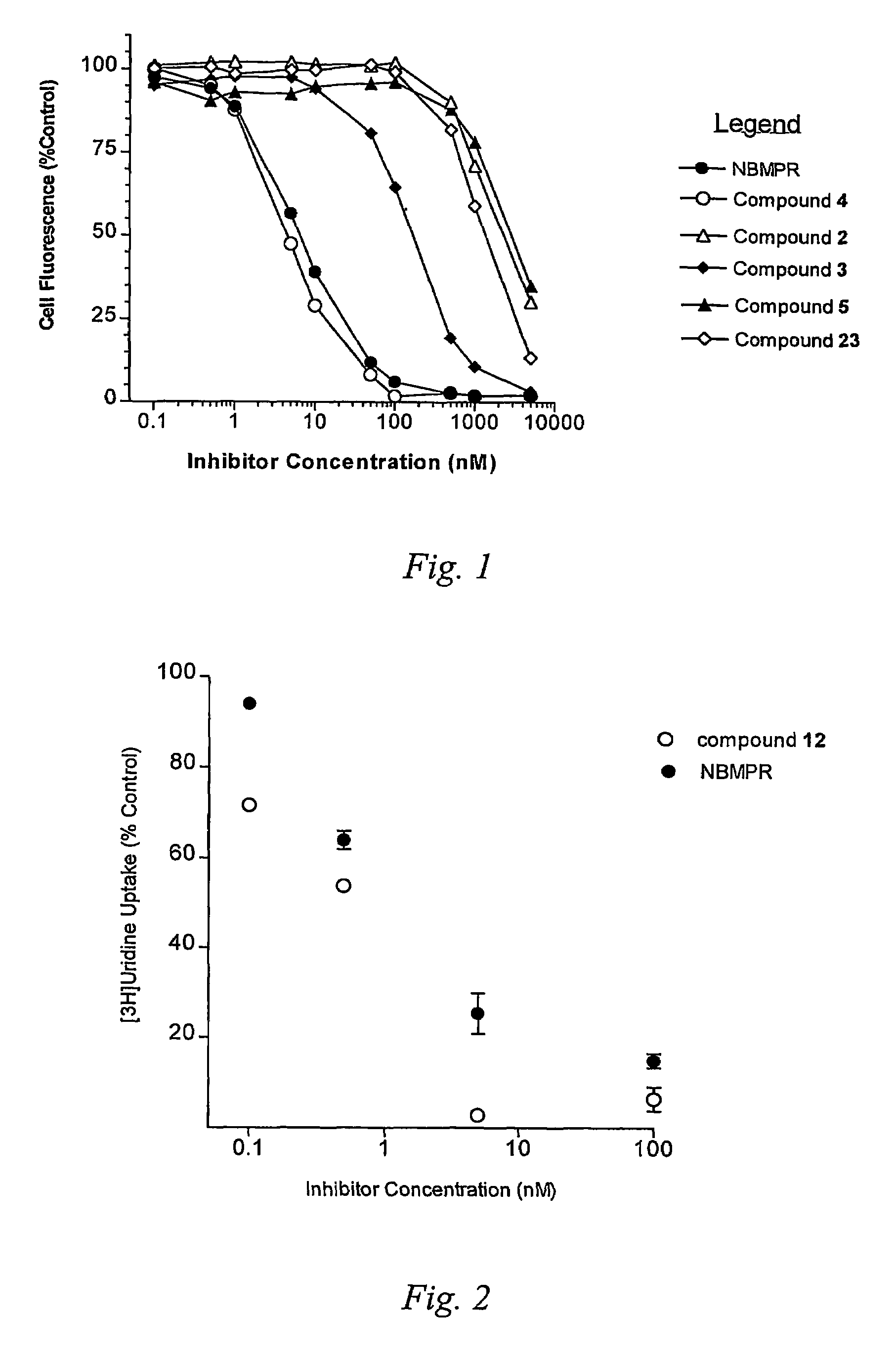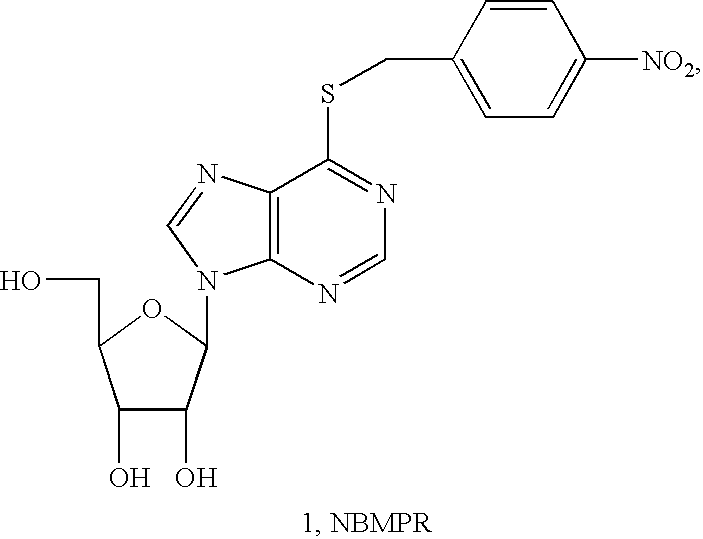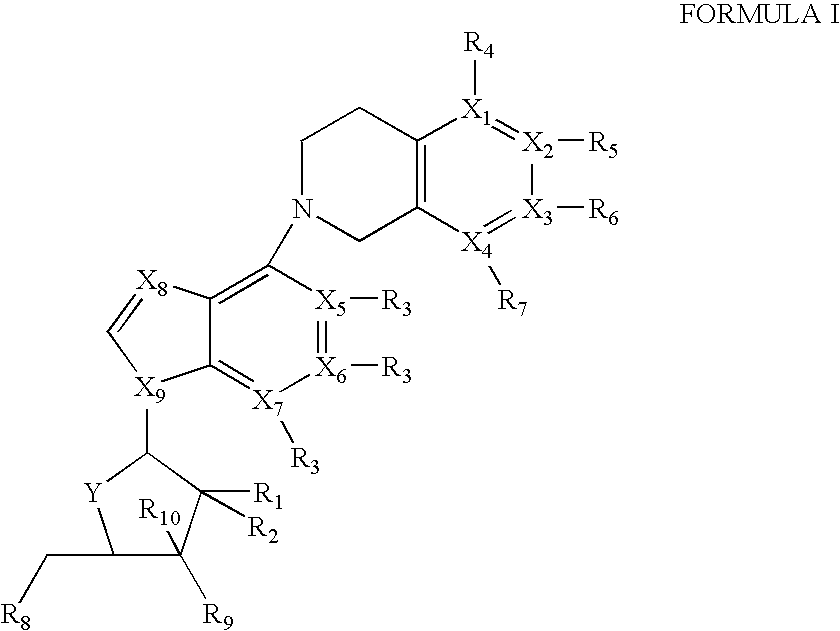Nucleoside transport inhibitors
a technology of nucleoside and transport inhibitor, which is applied in the field of compound, can solve the problems of reducing the effect of adenosine,
- Summary
- Abstract
- Description
- Claims
- Application Information
AI Technical Summary
Benefits of technology
Problems solved by technology
Method used
Image
Examples
example 1
[0047]This example shows how to make example compounds of the present invention. More specifically, this example demonstrates how to make four aromatic nitro isomers of 6-position nitro-1,2,3,4-tetrahydroisoquinolinylpurine ribosides NBMPR analogues (compounds 2-5). Several literature methods are employed to synthesize the required nitro-1,2,3,4-tetrahydroisoquinoline (compounds 6-9), which are subsequently reacted with the commercially available 6-chloropurine riboside (10) according to Scheme 1 to obtain the target compounds. The commercially available 5-nitroisoquinoline (11) is reduced using sodium borohydride in ethanol to afford the 5-tetrahydroisoquinoline (6) intermediate in good yield (about 90%). The 7-nitrotetrahydroisoquinoline intermediate (8) is prepared in about 50% yield by nitration of the commercially available 1,2,3,4-tetrahydroisoquinoline using KNO3 in concentrated sulfuric acid according to the method of Ajao et al. (1985) (Scheme 3). The 6- and 8-nitro-1,2,3,4...
example 2
Experimental
[0054]Chemistry. Thin-layer chromatography (TLC) is conducted on silica gel F254 plates (Analtech). Compounds are visualized by UV light or 5% H2SO4 in EtOH spraying reagent. 1H, 13C spectra are recorded on Bruker ARX (300 MHz) instruments, using CDCl3, CD3OD, (CD3)2SO or CD3COCD3 as solvents and tetramethylsilane (TMS) as internal standard. Flash column chromatography is performed on Fisher silica gel (170-400 mesh). Melting points are determined using a Fisher-Johns Melting Point Apparatus and are reported uncorrected. Mass spectra are obtained on a Bruker-HP Esquire-LC mass spectrometer, and IR spectra in KBr with a Perkin Elmer (System 2000 FT-IR) spectrometer. All solvents and reagents are bought from Aldrich and used without further purification.
example 3
General Method for Preparation of Compounds 2, 3, 4, 5, 22
[0055]A mixture of 6-chloropurine riboside (10, 100 mg, 0.35 mmol), (mono-NO2)-1,2,3,4-tetrahydroisoquinoline (0.88 mmol) and calcium carbonate (70 mg, 0.70 mmole) in EtOH (5 ml) is stirred under refluxing for 15 hours. The reaction mixture is filtered and the filtrate is removed by rotavapor. The residue is purified by chromatography followed by recrystallization in MeOH.
[0056]6-{[mono-(5, 6, 7, or 8)-NO2-]1,2,3,4-tetrahydroisoquino-2-yl}purine riboside (Compounds 2, 3, 4, 5, 22). Compound 2: yield 65%; mp 159-160° C.; IR: 3438, 1604, 1528, 1352 cm−1; 1H NMR (300 MHz, CDCl3) δ 8.15 (1H, s, H-2), 7.86 (1H, d, H-6″), 7.84 (1H, s, H-8), 7.49 (1H, d, H-8″), 7.36 (1H, t, H-7″), 6.53 (1H, br d, OH-2′), 5.81 (1H, d, H-1′), 5.36 (1H, br s, OH-3′), 5.07 (1H, q, H-2′), 4.53-4.45 (3H, br m, OH-5′, H-3′, 1″A), 4.35 (1H, s, H-1″B), 3.94 (1H, d, H-4′), 3.76 (2H, br m, H-5′), 3.28 (2H, t, H3″ or H4″). Anal. Calcd. For C19H20N6O6 (428.405):...
PUM
| Property | Measurement | Unit |
|---|---|---|
| temperature | aaaaa | aaaaa |
| temperature | aaaaa | aaaaa |
| temperature | aaaaa | aaaaa |
Abstract
Description
Claims
Application Information
 Login to View More
Login to View More - R&D
- Intellectual Property
- Life Sciences
- Materials
- Tech Scout
- Unparalleled Data Quality
- Higher Quality Content
- 60% Fewer Hallucinations
Browse by: Latest US Patents, China's latest patents, Technical Efficacy Thesaurus, Application Domain, Technology Topic, Popular Technical Reports.
© 2025 PatSnap. All rights reserved.Legal|Privacy policy|Modern Slavery Act Transparency Statement|Sitemap|About US| Contact US: help@patsnap.com



